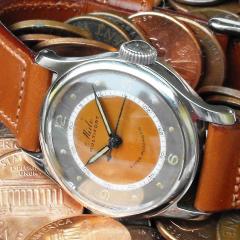Rolex 2135 not self winding very well...
-
Recently Browsing
- No registered users viewing this page.
-
Topics
-
Posts
-
Surely it depends on the clock , I only usually restore torsion clocks and I only use oil on mainspring ( small amount) but on the few so called normal pendulum clocks I have done I have used mainspring grease as there is more reserves of power than there is in a torsion clock so it is not so critical. Dell
-
https://watchguy.co.uk/cgi-bin/files?showfile=Venus/Venus 178.pdf&filename=Venus 178.pdf&dir=Technical Manuals&action=documents The hour recorder is driven by the barrel and it will only stop if it is held by the hour recorder stop lever 8690. So I would check if this lever (powered by the spring 8691) is really holding the hour recorder in the "chrono off status". I haven't worked on a Venus 178 so far, but on an Omega 861 I chose 9501 grease for the friction spring as it's moving very slow at quite high tension.
-
All I do is use a fine marker (sharpie) to put the service date on the back cover, this way it can be removed with some IPA and does no permanent damage to the watch. I'm in two minds about the whole service marking thing, sometimes it's good/bad to see the markings on the watch case back as you know it's been worked on and vice versa. However, if I took my car in for a service and the mechanic scratched some code into the housing of my engine I wouldn't be too impressed. Hence, I think my sharpie solution is a reasonable compromise.
-
hmmmm.... maybe there is a way to skin that cat 🙀 let me think on it... unless anyone else has any ideas? I left the opening in the side of the base and ring quite large to maybe allow you to grip the crown, but appreciate this may not always be possible, especially for small movements where the crown will not extend past the outer wall of the holder. I noticed this also, but after using the holder for a while I noticed that the ring/holder began to wear into shape (rough edges/bumps worn off) and the size became closer to the desired movement OD. Maybe with some trial and error we could add 0.5 mm (??) to the movement OD to allow for this initial bedding-in?
-
Hi nickelsilver, thanks for the great explanation and the links! I'll take a good look in the article. Especially this is great news to hear! Looking through forums and youtube videos I was informed to 'fist find a case and then fit a movement for it'. But seems that's not the case for pocket watches at least? I guess I should be looking to find some 'male square bench keys' for now. I was thinking of winding the mainspring using a screwdriver directly, but I found a thread that you've replied on, saying that it could damage the spring.
-







Recommended Posts
Join the conversation
You can post now and register later. If you have an account, sign in now to post with your account.
Note: Your post will require moderator approval before it will be visible.